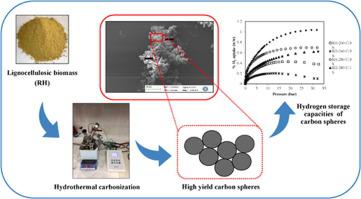Advanced Powder Technology ( IF 5.2 ) Pub Date : 2021-09-23 , DOI: 10.1016/j.apt.2021.09.025 Berna Koçer Kızılduman 1 , Yasemin Turhan 2 , Mehmet Doğan 2

|
In this study, carbon spheres were synthesized from rice husk with hydrothermal carbonization method at different temperatures and different reaction times. Surface areas and pore size distributions of carbon spheres were characterized by BET surface area device, sphere morphology by SEM, structural characterization by FTIR-ATR and XRD, and thermal properties and degradation mechanism by DTA/TG. In addition, hydrogen gas adsorption measurements of the samples were also carried out with the Hiden IMI PSI gas storage device. It can be said that the required temperature is 280 °C and the required reaction time is 6 h in order to obtain homogeneous and ideal sphere morphology carbon spheres from a lignocellulosic biomass in experiments carried out under different conditions in an acidic reaction medium. This is clearly seen from the SEM images. In addition, FTIR spectra and XRD patterns confirm that the sphere was obtained. According to the BET surface area and pore size distribution results, it can be said that the main significant difference is in the mesopore structure of the carbon spheres, even if the surface area values of the samples obtained at different temperatures and different reaction times increase linearly with temperature. In order to determine the usability of carbon spheres obtained in different conditions in the energy field, the gravimetrically measured H2 storage capacities at cryogenic temperature (77 K) and pressure range of 0–30 bar were determined as maximum 1.1% by weight. When the hydrogen storage capacities of the samples are evaluated together with the BET surface area values and pore size distributions, it shows that the hydrogen storage capacity in carbon spheres is directly proportional to the mesopore volumes. In addition, Langmuir and Freundlich isotherms related to adsorption equilibrium were investigated in order to better define the H2 adsorption that took place in these samples. Considering the regression coefficients of the obtained isotherms, it was determined that some of the carbon spheres were more compatible with the Langmuir isotherm and some with the Freundlich isotherm.
中文翻译:

稻壳热液碳化制备介孔碳球:优化、表征和储氢
本研究以稻壳为原料,采用水热碳化法在不同温度和不同反应时间下合成碳球。碳球的表面积和孔径分布通过BET表面积装置表征,球体形态通过SEM表征,结构表征通过FTIR-ATR和XRD,以及热性能和降解机制通过DTA/TG表征。此外,还使用 Hiden IMI PSI 储气装置对样品进行了氢气吸附测量。可以说,在酸性反应介质中不同条件下进行的实验中,为从木质纤维素生物质中获得均匀且理想的球形形态碳球,所需温度为 280 °C,所需反应时间为 6 h。这可以从 SEM 图像中清楚地看出。此外,FTIR 光谱和 XRD 图案证实获得了球体。根据BET表面积和孔径分布结果,可以说主要的显着差异在于碳球的介孔结构,即使在不同温度和不同反应时间下获得的样品的表面积值线性增加与温度。为了确定在能量场中不同条件下获得的碳球的可用性,重量测量的 H 即使在不同温度和不同反应时间下获得的样品的表面积值随温度线性增加。为了确定在能量场中不同条件下获得的碳球的可用性,重量测量的 H 即使在不同温度和不同反应时间下获得的样品的表面积值随温度线性增加。为了确定在能量场中不同条件下获得的碳球的可用性,重量测量的 H2在低温 (77 K) 和 0–30 bar 压力范围下的存储容量被确定为最大 1.1% 的重量。当将样品的储氢能力与 BET 表面积值和孔径分布一起评估时,表明碳球中的储氢能力与中孔体积成正比。此外,研究了与吸附平衡相关的 Langmuir 和 Freundlich 等温线,以便更好地定义这些样品中发生的 H 2吸附。考虑到获得的等温线的回归系数,确定一些碳球更符合朗缪尔等温线,而另一些则更符合 Freundlich 等温线。


























 京公网安备 11010802027423号
京公网安备 11010802027423号